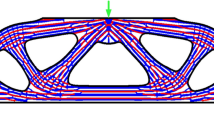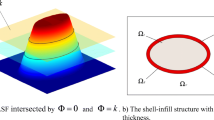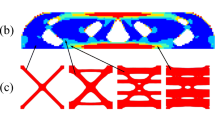Abstract
This paper presents a density-based topology optimization approach to design self-supporting and lightweight infill structures with efficient mechanical properties for enclosed structural shells. A new overhang constraint is developed based on the additive manufacturing (AM) filter to ensure that the infills are not only self-supporting in a specified manufacturing direction but can also provide necessary supports to the external shell for successful manufacturing. Two-field–based parametrization and topology optimization formulations are used to impose minimum length scales and to avoid the impractical design solutions that exhibit one-node connection structural members. Besides, a localized volume constraint is utilized to achieve a porous infill pattern. By solving the optimization problem, a shell-infill design can be obtained with very few overhang elements that can be easily post-processed without affecting the mechanical properties of the overall structure. As a result, the optimized design contains no overhang elements and exhibits a better mechanical property than that with predefined periodic infill patterns of the same weight. Numerical examples are given to demonstrate the effectiveness and applicability of the proposed approach.















Similar content being viewed by others
References
Andreassen E, Clausen A, Schevenels M, Lazarov BS, Sigmund O (2011) Efficient topology optimization in MATLAB using 88 lines of code. Struct Multidiscip Optim 43:1–16
Allaire G, Dapogny C, Estevez R, Faure A, Michailidis G (2017) Structural optimization under overhang constraints imposed by additive manufacturing technologies. J Comput Phys 351:295–328
Allaire G, Dapogny C, Faure A, Michailidis G (2017) Shape optimization of a layer by layer mechanical constraint for additive manufacturing. Comptes Rendus Mathematique 355:699–717
Allaire G, Dapogny C, Estevez R, Faure A, Michailidis G (2017) Structural optimization under overhang constraints imposed by additive manufacturing processes: an overview of some recent results. Appl Math Nonlinear Sci 2(2):385–402
Bendsøe MP, Kikuchi N (1988) Generating optimal topologies in structural design using a homogenization method. Comput Methods Appl Mech Eng 71(2):197–224
Bendsøe MP, Sigmund O (2003) Topology optimization-theory methods and applications. Springer, Berlin
Bourdin B (2001) Filters in topology optimization. Int J Numer Methods Eng 50(9):2143–2158
Bruns TE, Tortorelli DA (2001) Topology optimization of nonlinear elastic structures and compliant mechanisms. Comput Methods Appl Mech Eng 190(26–27):3443–3459
Cheng L, Liu J, To AC (2018) Concurrent lattice infill with feature evolution optimization for additivemanufactured heat conduction design. Struct Multidiscip Optim 58:511–535
Clausen A, Aage N, Sigmund O (2015) Topology optimization of coated structures and material interface problems. Comput Methods Appl Mech Engrg 290:524–541
Garaigordobil A, Ansola R, Santamaría J, Fernández de Bustos I (2018) A new overhang constraint for topology optimization of self-supporting structures in additive manufacturing. Struct Multidiscip Optim 58:2003–2017
Gaynor AT, Guest JK (2016) Topology optimization considering overhang constraints: Eliminating sacrificial support material in additive manufacturing through design. Struct Multidiscip Optim 54:1157–1172
Guest JK, Prévost JH, Belytschko T (2004) Achieving minimum length scale in topology optimization using nodal design variables and projection functions. Int J Numer Methods Eng 61(2):238–254
Guo X, Zhou J, Zhang W, Du Z, Liu C, Liu Y (2017) Self-supporting structure design in additive manufacturing through explicit topology optimization. Comput Methods Appl Mech Eng 323:27–63
Groen JP, Wu J, Sigmund O (2019) Homogenization-based stiffness optimization and projection of 2D coated structures with orthotropic infill. Comput Methods Appl Mech Engrg 349:722–742
Jiang L, Guo Y, Chen S, Wei P, Lei N, Gu XD (2019) Concurrent optimization of structural topology and infill properties with a CBF-based level set method. Front Mech Eng 14(2):171–189
Khan SA, Siddiqui BA, Fahad M, Khan MA (2017) Evaluation of the effect of infill pattern on mechanical stregnth of additively manufactured specimen. Mater Sci Forum 887:128–132
Langelaar M (2016) Topology optimization of 3D self-supporting structures for additive manufacturing. Addit Manuf 12:60– 70
Langelaar M (2017) An additive manufacturing filter for topology optimization of print-ready designs. Struct Multidiscip Optim 55:871–883
Lazarov BS, Wang F, Sigmund O (2016) Length scale and manufacturability in density-based topology optimization. Arch Appl Mech 86:189–218
Li D, Liao W, Dai N, Dong G, Tang Y, Xie YM (2018) Optimal design and modeling of gyroid-based functionally graded cellular structures for additive manufacturing. Comput -Aided Des 104:87–99
Pellens J, Lombaert G, Lazarov B, Schevenels M (2019) Combined length scale and overhang angle control in minimum compliance topology optimization for additive manufacturing. Struct Multidiscip Optim 59:2005–2022
Qian X (2017) Undercut and overhang angle control in topology optimization: a density gradient based integral. Int J Numer Methods Eng 111(3):247–272
Schmidt M, Pedersen C, Gout C (2019) On structural topology optimization using graded porousity control. Struct Multidiscip Optim 60:1437–1453
Sigmund O (2007) Morphology-based black and white filters for topology optimization. Struct Multidiscip Optim 33(4):401– 424
Sigmund O, Maute K (2013) Topology optimization approaches. Struct Multidiscip Optim 48:1031–1055
Svanberg K (1987) The method of moving asymptotes: a new method for structural optimization. Int J Numer Methods Eng 24(2):359–373
van de Ven E, Maas R, Ayas C, Langelaar M, van Keulen F (2018) Continuous front propagation-based overhang control for topology optimization with additive manufacturing. Struct Multidiscip Optim 57:2075–2091
van de Ven E, Maas R, Ayas C, Langelaar M, van Keulen F (2020) Overhang control based on front propagation in 3D topology optimization for additive manufacturing. Comput Methods Appl Mech Eng 369:113169
Wadbro E, Niu B (2019) Multiscale design for additive manufactured structures with solid coating and periodic infill pattern. Comput Methods Appl Mech Engrg 357:112605
Wang D, Mai S, Xiao D, Yang Y (2016) Surface quality of the curved overhanging structure manufactured from 316-L stainless steel by SLM. Int J Adv Manuf Technol 86:781–792
Wang F, Lazarov BS, Sigmund O (2011) On projection methods, convergence and robust formulations in topology optimization. Struct Multidiscip Optim 43(6):767–784
Wu J, Aage N, Westermann R, Sigmund O (2018) Infill optimization for additive manufacturing-approaching bone-like porous structures. IEEE Trans Vis Comput Graph 24(2):1127–1140
Wu J, Clausen A, Sigmund O (2017) Minimum compliance topology optimization of shell-infill composites for additive manufacturing. Comput Methods Appl Mech Engrg 326:358–375
Wu J, Wang CCL, Zhang X, Westermann R (2016) Self-supporting rhombic infill structures for additive manufacturing. Comput -Aided Des 80:32–42
Yu H, Huang J, Zou B, Shao W, Liu J (2020) Stress-constrained shell-lattice infill structural optimisation for additive manufacturing. Virt Phys Protot 15(1):35–48
Zhang K, Cheng G, Xu L (2019) Topology optimization considering overhang constraint in additive manufacturing. Comput Struct 212:86–100
Zhang W, Zhou L (2018) Topology optimization of self-supporting structures with polygon features for additive manufacturing. Comput Methods Appl Mech Eng 334:56–78
Zhou M, Liu Y, Lin Z (2019) Topology optimization of thermal conductive support structures for laser additive manufacturing. Comput Methods Appl Mech Eng 353:24–43
Funding
The authors received support from National Natural Science Foundation of China (Grant No. 52075321).
Author information
Authors and Affiliations
Corresponding author
Ethics declarations
Conflict of interest
The authors declare that they have no conflict of interest.
Replication of results
On behalf of all authors, the corresponding author states that the results presented in this paper can be reproduced by the implementation details provided herein. The computer codes and data used to draw figures will not be provided in this paper.
Additional information
Responsible Editor: Gregoire Allaire
Publisher’s note
Springer Nature remains neutral with regard to jurisdictional claims in published maps and institutional affiliations.
Appendix
Appendix
The sensitivity of the overhang constraint function G in (10) is calculated by the chain rule:
where M is the total number of element in the building chamber Ω∗. \(\frac {\partial \check {\phi }_{m}}{\partial \bar {\phi }_{n}}\), \(\frac {\partial \bar {\phi }_{n}}{\partial \tilde {\phi }_{i}}\cdot \), \(\frac {\partial \tilde {\phi }_{i}}{\partial \phi _{e}}\) are given as followed:
Besides, \(\frac {\partial G}{\partial \check {\phi }_{m}}\) is calculated as follows:
where \({\sum }_{j=1}^{M} max\{(\check {\phi }_{j}-\hat {\phi }_{j}), 0 \} \frac {\partial \hat {\phi }_{j}}{\partial \check {\phi }_{m}}\) can be calculated by the formulation in Langelaar (2017).
The finite difference check for the sensitivity of the overhang constraint is plotted in Fig. 16, where the horizontal axis is the disturbance in one of the design variables, the vertical axis is the relative error between the sensitivity calculated by (21)–(25), and the sensitivity calculated by finite difference.
Rights and permissions
About this article
Cite this article
Liu, Y., Zhou, M., Wei, C. et al. Topology optimization of self-supporting infill structures. Struct Multidisc Optim 63, 2289–2304 (2021). https://doi.org/10.1007/s00158-020-02805-y
Received:
Revised:
Accepted:
Published:
Issue Date:
DOI: https://doi.org/10.1007/s00158-020-02805-y





